Jianping Yao
Multi-output Deep-Supervised Classifier Chains for Plant Pathology
Jul 27, 2025Abstract:Plant leaf disease classification is an important task in smart agriculture which plays a critical role in sustainable production. Modern machine learning approaches have shown unprecedented potential in this classification task which offers an array of benefits including time saving and cost reduction. However, most recent approaches directly employ convolutional neural networks where the effect of the relationship between plant species and disease types on prediction performance is not properly studied. In this study, we proposed a new model named Multi-output Deep Supervised Classifier Chains (Mo-DsCC) which weaves the prediction of plant species and disease by chaining the output layers for the two labels. Mo-DsCC consists of three components: A modified VGG-16 network as the backbone, deep supervision training, and a stack of classification chains. To evaluate the advantages of our model, we perform intensive experiments on two benchmark datasets Plant Village and PlantDoc. Comparison to recent approaches, including multi-model, multi-label (Power-set), multi-output and multi-task, demonstrates that Mo-DsCC achieves better accuracy and F1-score. The empirical study in this paper shows that the application of Mo-DsCC could be a useful puzzle for smart agriculture to benefit farms and bring new ideas to industry and academia.
Wine Characterisation with Spectral Information and Predictive Artificial Intelligence
Jul 27, 2025Abstract:The purpose of this paper is to use absorbance data obtained by human tasting and an ultraviolet-visible (UV-Vis) scanning spectrophotometer to predict the attributes of grape juice (GJ) and to classify the wine's origin, respectively. The approach combined machine learning (ML) techniques with spectroscopy to find a relatively simple way to apply them in two stages of winemaking and help improve the traditional wine analysis methods regarding sensory data and wine's origins. This new technique has overcome the disadvantages of the complex sensors by taking advantage of spectral fingerprinting technology and forming a comprehensive study of the employment of AI in the wine analysis domain. In the results, Support Vector Machine (SVM) was the most efficient and robust in both attributes and origin prediction tasks. Both the accuracy and F1 score of the origin prediction exceed 91%. The feature ranking approach found that the more influential wavelengths usually appear at the lower end of the scan range, 250 nm (nanometers) to 420 nm, which is believed to be of great help for selecting appropriate validation methods and sensors to extract wine data in future research. The knowledge of this research provides new ideas and early solutions for the wine industry or other beverage industries to integrate big data and IoT in the future, which significantly promotes the development of 'Smart Wineries'.
Sensing-Assisted Channel Prediction in Complex Wireless Environments: An LLM-Based Approach
May 14, 2025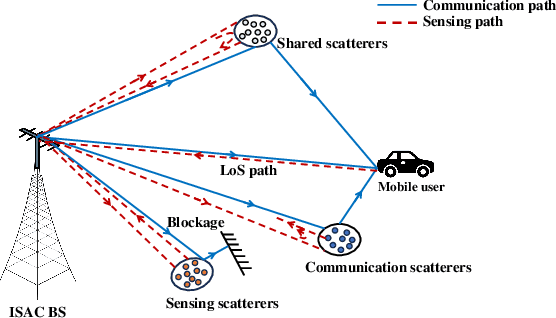
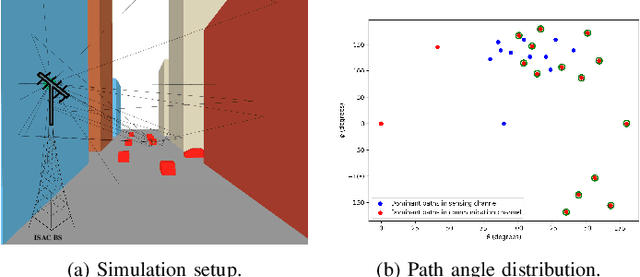

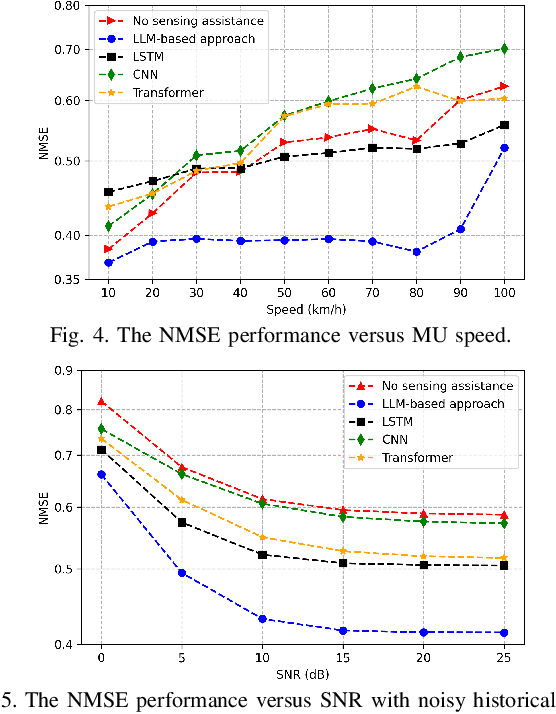
Abstract:This letter studies the sensing-assisted channel prediction for a multi-antenna orthogonal frequency division multiplexing (OFDM) system operating in realistic and complex wireless environments. In this system,an integrated sensing and communication (ISAC) transmitter leverages the mono-static sensing capability to facilitate the prediction of its bi-static communication channel, by exploiting the fact that the sensing and communication channels share the same physical environment involving shared scatterers. Specifically, we propose a novel large language model (LLM)-based channel prediction approach,which adapts pre-trained text-based LLM to handle the complex-matrix-form channel state information (CSI) data. This approach utilizes the LLM's strong ability to capture the intricate spatiotemporal relationships between the multi-path sensing and communication channels, and thus efficiently predicts upcoming communication CSI based on historical communication and sensing CSI data. Experimental results show that the proposed LLM-based approach significantly outperforms conventional deep learning-based methods and the benchmark scheme without sensing assistance.
UAV-Enabled Secure ISAC Against Dual Eavesdropping Threats: Joint Beamforming and Trajectory Design
Dec 27, 2024

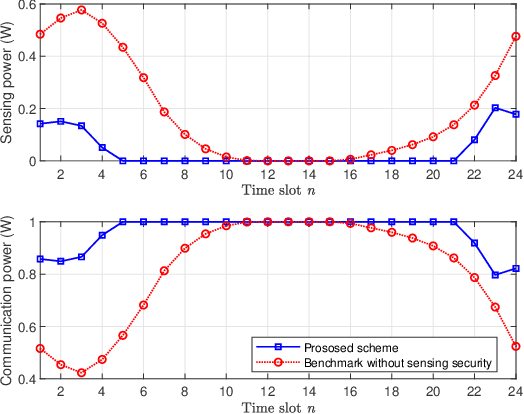

Abstract:In this work, we study an unmanned aerial vehicle (UAV)-enabled secure integrated sensing and communication (ISAC) system, where a UAV serves as an aerial base station (BS) to simultaneously perform communication with a user and detect a target on the ground, while a dual-functional eavesdropper attempts to intercept the signals for both sensing and communication. Facing the dual eavesdropping threats, we aim to enhance the average achievable secrecy rate for the communication user by jointly designing the UAV trajectory together with the transmit information and sensing beamforming, while satisfying the requirements on sensing performance and sensing security, as well as the UAV power and flight constraints. To address the non-convex nature of the optimization problem, we employ the alternating optimization (AO) strategy, jointly with the successive convex approximation (SCA) and semidefinite relaxation (SDR) methods. Numerical results validate the proposed approach, demonstrating its ability to achieve a high secrecy rate while meeting the required sensing and security constraints.
Seamlessly merging radar ranging/imaging, wireless communications, and spectrum sensing, for 6G empowered by microwave photonics
Apr 08, 2024



Abstract:Integration of radar, wireless communications, and spectrum sensing is being investigated for 6G with an increased spectral efficiency. Microwave photonics (MWP), a technique that combines microwave engineering and photonic technology to take advantage of the wide bandwidth offered by photonics for microwave signal generation and processing is considered an effective solution for the implementation of the integration. In this paper, an MWP-assisted joint radar, wireless communications, and spectrum sensing (JRCSS) system that enables precise perception of the surrounding physical and electromagnetic environments while maintaining high-speed data communication is proposed and demonstrated. Communication signals and frequency-sweep signals are merged in the optical domain to achieve high-speed radar ranging and imaging, high-data-rate wireless communications, and wideband spectrum sensing. In an experimental demonstration, a JRCSS system supporting radar ranging with a measurement error within $\pm$ 4 cm, two-dimensional imaging with a resolution of 25 $\times$ 24.7 mm, wireless communications with a data rate of 2 Gbaud, and spectrum sensing with a frequency measurement error within $\pm$ 10 MHz in a 6-GHz bandwidth, is demonstrated.
Deep Learning for Plant Identification and Disease Classification from Leaf Images: Multi-prediction Approaches
Oct 25, 2023

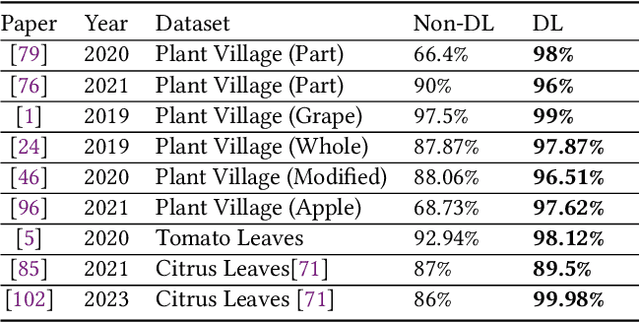
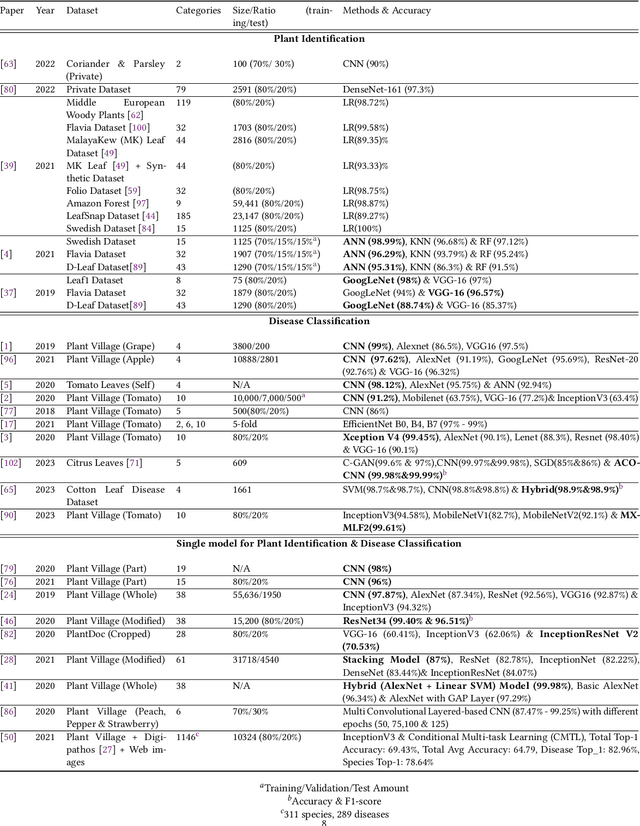
Abstract:Deep learning plays an important role in modern agriculture, especially in plant pathology using leaf images where convolutional neural networks (CNN) are attracting a lot of attention. While numerous reviews have explored the applications of deep learning within this research domain, there remains a notable absence of an empirical study to offer insightful comparisons due to the employment of varied datasets in the evaluation. Furthermore, a majority of these approaches tend to address the problem as a singular prediction task, overlooking the multifaceted nature of predicting various aspects of plant species and disease types. Lastly, there is an evident need for a more profound consideration of the semantic relationships that underlie plant species and disease types. In this paper, we start our study by surveying current deep learning approaches for plant identification and disease classification. We categorise the approaches into multi-model, multi-label, multi-output, and multi-task, in which different backbone CNNs can be employed. Furthermore, based on the survey of existing approaches in plant pathology and the study of available approaches in machine learning, we propose a new model named Generalised Stacking Multi-output CNN (GSMo-CNN). To investigate the effectiveness of different backbone CNNs and learning approaches, we conduct an intensive experiment on three benchmark datasets Plant Village, Plant Leaves, and PlantDoc. The experimental results demonstrate that InceptionV3 can be a good choice for a backbone CNN as its performance is better than AlexNet, VGG16, ResNet101, EfficientNet, MobileNet, and a custom CNN developed by us. Interestingly, empirical results support the hypothesis that using a single model can be comparable or better than using two models. Finally, we show that the proposed GSMo-CNN achieves state-of-the-art performance on three benchmark datasets.
Machine Learning for Leaf Disease Classification: Data, Techniques and Applications
Oct 19, 2023Abstract:The growing demand for sustainable development brings a series of information technologies to help agriculture production. Especially, the emergence of machine learning applications, a branch of artificial intelligence, has shown multiple breakthroughs which can enhance and revolutionize plant pathology approaches. In recent years, machine learning has been adopted for leaf disease classification in both academic research and industrial applications. Therefore, it is enormously beneficial for researchers, engineers, managers, and entrepreneurs to have a comprehensive view about the recent development of machine learning technologies and applications for leaf disease detection. This study will provide a survey in different aspects of the topic including data, techniques, and applications. The paper will start with publicly available datasets. After that, we summarize common machine learning techniques, including traditional (shallow) learning, deep learning, and augmented learning. Finally, we discuss related applications. This paper would provide useful resources for future study and application of machine learning for smart agriculture in general and leaf disease classification in particular.
Secrecy Offloading Rate Maximization for Multi-Access Mobile Edge Computing Networks
Sep 21, 2021
Abstract:This letter considers a multi-access mobile edge computing (MEC) network consisting of multiple users, multiple base stations, and a malicious eavesdropper. Specifically, the users adopt the partial offloading strategy by partitioning the computation task into several parts. One is executed locally and the others are securely offloaded to multiple MEC servers integrated into the base stations by leveraging the physical layer security to combat the eavesdropping. We jointly optimize power allocation, task partition, subcarrier allocation, and computation resource to maximize the secrecy offloading rate of the users, subject to communication and computation resource constraints. Numerical results demonstrate that our proposed scheme can respectively improve the secrecy offloading rate 1.11%--1.39% and 15.05%--17.35% (versus the increase of tasks' latency requirements), and 1.30%--1.75% and 6.08%--9.22% (versus the increase of the maximum transmit power) compared with the two benchmarks. Moreover, it further emphasizes the necessity of conducting computation offloading over multiple MEC servers.
 Add to Chrome
Add to Chrome Add to Firefox
Add to Firefox Add to Edge
Add to Edge